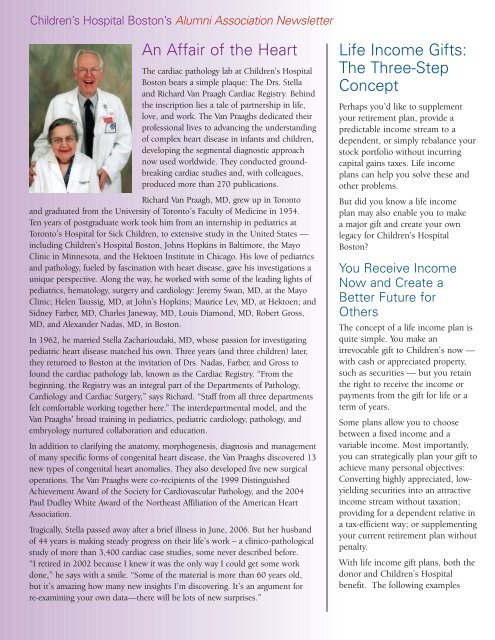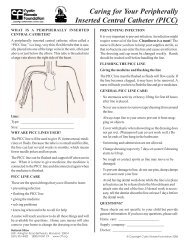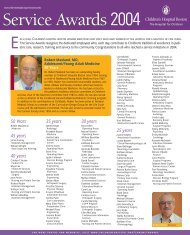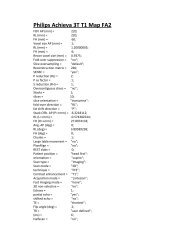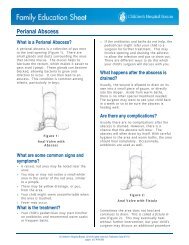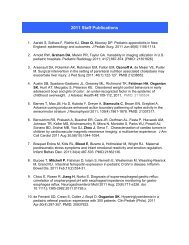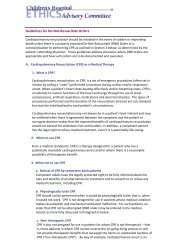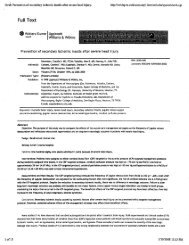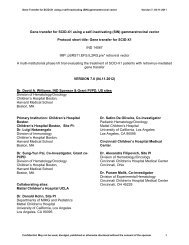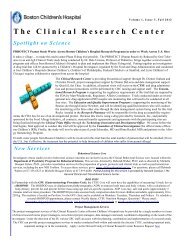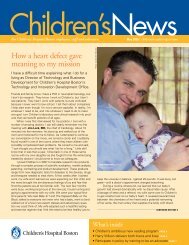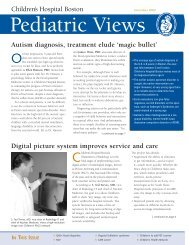Alumni Association Newsletter - Children's Hospital Boston
Alumni Association Newsletter - Children's Hospital Boston
Alumni Association Newsletter - Children's Hospital Boston
You also want an ePaper? Increase the reach of your titles
YUMPU automatically turns print PDFs into web optimized ePapers that Google loves.
Children’s <strong>Hospital</strong> <strong>Boston</strong>’s <strong>Alumni</strong> <strong>Association</strong> <strong>Newsletter</strong><br />
An Affair of the Heart<br />
The cardiac pathology lab at Children’s <strong>Hospital</strong><br />
<strong>Boston</strong> bears a simple plaque: The Drs. Stella<br />
and Richard Van Praagh Cardiac Registry. Behind<br />
the inscription lies a tale of partnership in life,<br />
love, and work. The Van Praaghs dedicated their<br />
professional lives to advancing the understanding<br />
of complex heart disease in infants and children,<br />
developing the segmental diagnostic approach<br />
now used worldwide. They conducted groundbreaking<br />
cardiac studies and, with colleagues,<br />
produced more than 270 publications.<br />
Richard Van Praagh, MD, grew up in Toronto<br />
and graduated from the University of Toronto’s Faculty of Medicine in 1954.<br />
Ten years of postgraduate work took him from an internship in pediatrics at<br />
Toronto’s <strong>Hospital</strong> for Sick Children, to extensive study in the United States —<br />
including Children’s <strong>Hospital</strong> <strong>Boston</strong>, Johns Hopkins in Baltimore, the Mayo<br />
Clinic in Minnesota, and the Hektoen Institute in Chicago. His love of pediatrics<br />
and pathology, fueled by fascination with heart disease, gave his investigations a<br />
unique perspective. Along the way, he worked with some of the leading lights of<br />
pediatrics, hematology, surgery and cardiology: Jeremy Swan, MD, at the Mayo<br />
Clinic; Helen Taussig, MD, at John’s Hopkins; Maurice Lev, MD, at Hektoen; and<br />
Sidney Farber, MD, Charles Janeway, MD, Louis Diamond, MD, Robert Gross,<br />
MD, and Alexander Nadas, MD, in <strong>Boston</strong>.<br />
In 1962, he married Stella Zacharioudaki, MD, whose passion for investigating<br />
pediatric heart disease matched his own. Three years (and three children) later,<br />
they returned to <strong>Boston</strong> at the invitation of Drs. Nadas, Farber, and Gross to<br />
found the cardiac pathology lab, known as the Cardiac Registry. “From the<br />
beginning, the Registry was an integral part of the Departments of Pathology,<br />
Cardiology and Cardiac Surgery,” says Richard. “Staff from all three departments<br />
felt comfortable working together here.” The interdepartmental model, and the<br />
Van Praaghs’ broad training in pediatrics, pediatric cardiology, pathology, and<br />
embryology nurtured collaboration and education.<br />
In addition to clarifying the anatomy, morphogenesis, diagnosis and management<br />
of many specific forms of congenital heart disease, the Van Praaghs discovered 13<br />
new types of congenital heart anomalies. They also developed five new surgical<br />
operations. The Van Praaghs were co-recipients of the 1999 Distinguished<br />
Achievement Award of the Society for Cardiovascular Pathology, and the 2004<br />
Paul Dudley White Award of the Northeast Affiliation of the American Heart<br />
<strong>Association</strong>.<br />
Tragically, Stella passed away after a brief illness in June, 2006. But her husband<br />
of 44 years is making steady progress on their life’s work – a clinico-pathological<br />
study of more than 3,400 cardiac case studies, some never described before.<br />
“I retired in 2002 because I knew it was the only way I could get some work<br />
done,” he says with a smile. “Some of the material is more than 60 years old,<br />
but it’s amazing how many new insights I’m discovering. It’s an argument for<br />
re-examining your own data—there will be lots of new surprises.”<br />
Life Income Gifts:<br />
The Three-Step<br />
Concept<br />
Perhaps you’d like to supplement<br />
your retirement plan, provide a<br />
predictable income stream to a<br />
dependent, or simply rebalance your<br />
stock portfolio without incurring<br />
capital gains taxes. Life income<br />
plans can help you solve these and<br />
other problems.<br />
But did you know a life income<br />
plan may also enable you to make<br />
a major gift and create your own<br />
legacy for Children’s <strong>Hospital</strong><br />
<strong>Boston</strong>?<br />
You Receive Income<br />
Now and Create a<br />
Better Future for<br />
Others<br />
The concept of a life income plan is<br />
quite simple. You make an<br />
irrevocable gift to Children’s now —<br />
with cash or appreciated property,<br />
such as securities — but you retain<br />
the right to receive the income or<br />
payments from the gift for life or a<br />
term of years.<br />
Some plans allow you to choose<br />
between a fixed income and a<br />
variable income. Most importantly,<br />
you can strategically plan your gift to<br />
achieve many personal objectives:<br />
Converting highly appreciated, lowyielding<br />
securities into an attractive<br />
income stream without taxation;<br />
providing for a dependent relative in<br />
a tax-efficient way; or supplementing<br />
your current retirement plan without<br />
penalty.<br />
With life income gift plans, both the<br />
donor and Children’s <strong>Hospital</strong><br />
benefit. The following examples


